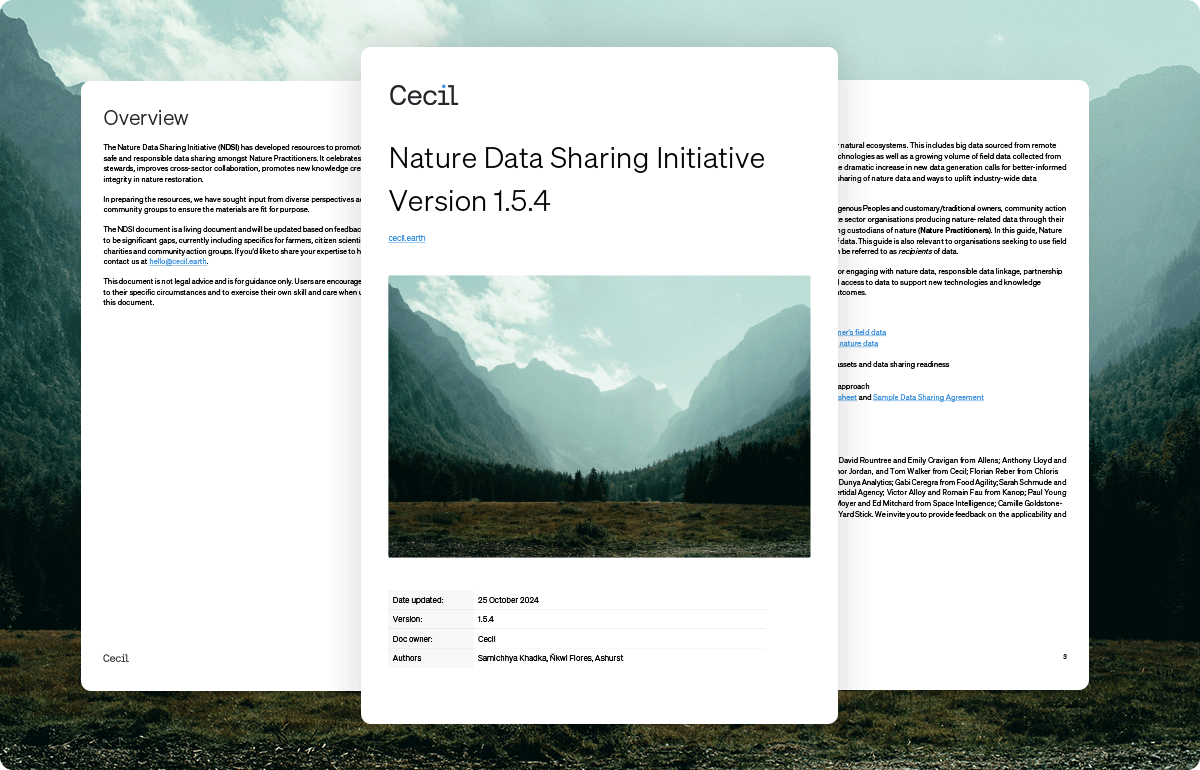The case for nature data sharing
Introducing the Nature Data Sharing Initiative (NDSI)
Welcome to the nature data newsletter. Each month, we share insights with data enthusiasts, GIS experts, and investors learning about nature data.
Most nature data is siloed in repositories and used by a very narrow audience today. Yet, if properly activated, this data could greatly improve our ability to understand and value natural ecosystems. At Cecil, we believe that an equitable data sharing culture can celebrate and appropriately compensate land stewards, improve cross-sector collaboration, and lead to new insights and knowledge — ultimately raising the bar on integrity in nature markets.
Today we're excited to start a new multi-part series focused on data sharing. We'll begin by introducing the concept of nature data sharing, the challenges faced and explain its importance. We’ll then share details on the launch of our Nature Data Sharing Initiative - a collection of resources to promote responsible, impactful data sharing among teams working on nature.
Nature data sharing: addressing the gap
Petabytes of nature data have already been generated, including remote sensing data and a large volume of field data from sampling sites distributed across the globe. Yet, one of the most common challenges we hear from teams working in this space is that they don’t have the data they need to make progress.
From companies building nature-tech applications, to corporates wanting to assess their nature-related risks, more questions are being asked about the availability of data and how it can be accessed thoughtfully - ensuring legal, ethical, and cultural considerations are met.
At the same time, various groups are generating nature data every day. They include land stewards, Indigenous Peoples, customary and traditional owners, community action groups, nonprofits, and private sector organisations. However, these groups often lack the resources and data capability to fully grasp their data sharing options. This results in missed opportunities, duplicated work, and siloed data.
For example:
Land stewards gather baseline field data before launching a forest carbon project. This data could include biomass and tree metrics, geospatial coordinates, text records, georeferenced images, and other relevant metadata.
Commercial data providers need field data for model training and validation, but find it challenging to source and collect new data.
As a result, without a shared vocabulary or standardised framework, it is challenging for different groups to align on interests, risks, and mutual motivations for data sharing.
Similar challenges once existed in venture capital, where early-stage startup founders lacked the resources and knowledge to negotiate early funding rounds. Tools like Y Combinator’s SAFE notes were created to offer balanced terms for both startups and investors.
The Importance of Nature Data Sharing
Representing our natural world through data requires a mosaic of digitised information that is collected in a spatially explicit, temporally explicit, accurate, and precise manner. As a result, it is hard to imagine a future that doesn’t include a framework for data sharing.
To achieve this, we believe coordinated action is essential. Here are a few examples of steps we can take together.
Fill data gaps and increase accessibility
Field data is typically collected by individual organisations or community groups, siloed, and often remains fragmented and inaccessible. Making this data available can help fill critical gaps, such as for the one in six IUCN-listed species that lack sufficient data.
Create new revenue streams for data collection
Collecting field data is costly and time consuming. There is a need for new pathways to finance and compensate data generation by Indigenous Peoples and Local Communities. Implementing principles like CARE (Collective Benefit, Authority to Control, Responsibility, and Ethics) can promote responsible data management and ensure fair compensation for this specialised work.
Support innovation
Field data is essential for driving innovation in nature conservation, restoration, and stewardship. It serves as the gold standard for measuring natural systems, validating new technologies, and improving machine learning models that rely on ex-situ data (e.g satellites). Field data also supports scientific research, helping us better understand ecosystems, biodiversity, and the services they provide.
Announcing the Nature Data Sharing Initiative (NDSI)
We are excited to announce the Nature Data Sharing Initiative (NDSI). NDSI is a collection of resources designed to promote data literacy and foster a culture of responsible, impactful data sharing among teams working on nature.
NDSI includes the following key resources:
Overview: An introduction, overview, and guidance notes around nature data and Nature Practitioners’ field data;
Guide: A guide on practical steps for sharing data;
Template: A data sharing worksheet and sample data sharing agreement template.
Cecil developed the NDSI in collaboration with numerous experts. A special thank you to: David Rountree and Emily Cravigan from Allens; Anthony Lloyd and Kendrick Deng from Ashurst; Alex Logan, Connor Jordan, and Tom Walker from Cecil; Florian Reber from Chloris Geospatial; Climateworks; Megan Pillsbury from Dunya Analytics; Gabi Ceregra from Food Agility; Sarah Schmude and Bert Glover from Impact Ag; Kate Wing from Intertidal Agency; Victor Alloy and Romain Fau from Kanop; Paul Young from Kita; Ňkwi Flores; Karl Burkart from One Earth; Alexis Moyer and Ed Mitchard from Space Intelligence; Samichhya Khadka; Camille Goldstone-Henry from Xylo Systems; and Chris Tolles from Yard Stick.
If you’d like to contribute your expertise to this initiative, please reach out to us at alex@cecil.earth.
In future newsletters, we'll continue our focus on data sharing by exploring topics such as the significance of indigenous rights and field data, and offer other practical solutions for improving access to nature data.
Keep reading
This newsletter is curated by Cecil, a team on a mission to make nature data accessible. Their platform helps data teams access analysis-ready commercial and public nature datasets, eliminating the need for cleaning, harmonising, and pre-processing tasks. Whilst currently focused on aboveground biomass, they will soon launch land cover and land use datasets to support market-leading nature-tech applications, consultants, and nature restoration professionals.
Enjoy the newsletter? Please forward to a friend.


